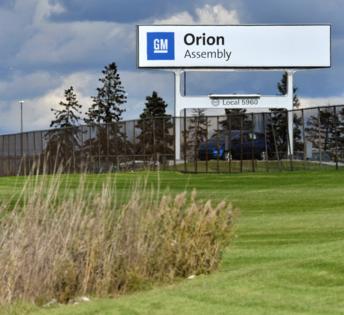GM plans $4 billion push to move production from Mexico to US
Published in Automotive News
General Motors Co. plans to invest $4 billion to move production from Mexico to three plants in the United States, including its Orion Assembly Plant in suburban Detroit, three sources familiar with the situation told The Detroit News.
Full-size SUVs and light-duty pickups are coming to Orion, which was being retooled to build electric trucks before market demand waned. The gas-powered Equinox compact SUV is slated for Fairfax, Kansas. And the gas-powered Blazer, controversial when it was launched at a GM plant in Mexico, will be produced in Spring Hill, Tennessee, the sources confirmed.
After The Detroit News contacted GM Tuesday afternoon about the developments, the automaker posted details on its website.
“We believe the future of transportation will be driven by American innovation and manufacturing expertise,” GM CEO Mary Barra said in a statement. “Today’s announcement demonstrates our ongoing commitment to build vehicles in the U.S and to support American jobs. We're focused on giving customers choice and offering a broad range of vehicles they love.”
The move is partly driven by increased demand for high-profit SUVs and partly an effort to limit exposure to pricey import tariffs enacted by President Donald Trump. His goal: to force a manufacturing renaissance in the industrial heartland and beyond. When GM announced plans to reopen Orion in 2022, the state estimated the project would create 2,300 jobs and retain 1,000.
GM's manufacturing reshoring is likely to be considered a major victory for Trump's trade-and-tariffs policy — and could be a harbinger of additional moves by manufacturers foreign and domestic. The move likely ranks among the largest — if not the largest — reshoring of U.S. auto manufacturing since Trump took office for a second term.
Reshoring American auto jobs has been a longstanding promise from Trump, on the campaign trail in Michigan and during his two stints in the Oval Office. Since returning to Washington in January, Trump has used tariff policies to up pressure on automakers to locate more of their production in the United States.
“We give them a little bit of time before we slaughter them if they don’t do this," Trump said during an April visit to Macomb County to mark the first 100 days of his second term.
That evening, Trump also announced that he planned to offer "partial tariff rebates" for about two years to companies that assemble cars in the United States. He had previously planned to impose a 25% tariff on foreign auto parts to take effect in May. He said the new rebates would provide a "little bit of a flexibility."
The Republican president, separately, has also enacted a 25% tariff on all imported vehicles and auto parts from Canada and Mexico that do not comply with the countries' U.S.-Mexico-Canada free trade agreement.
He granted the USMCA exemption after intense lobbying and direct conversations with leaders of the Detroit Three automakers. The companies warned of dire consequences from disrupting North America's highly interconnected automotive supply chain, with Michigan likely to suffer the most.
Last month, GM announced an $888 million investment in V-8 propulsion engines at the company's Tonawanda Propulsion plant in Buffalo, New York. At the time, CEO Mary Barra said the massive capital infusion shows "our commitment to strengthening American manufacturing and supporting jobs in the U.S."
GM last month amended its guidance for the year to include tariff exposure of $4 billion to $5 billion, although that was before Trump offered some relief to automakers.
Barra had said the company expected to offset tariff costs by about 30% in part by tightening budgeting and moving more supplies and manufacturing to the United States. The Mexico-to-United States shift in production, expected to take effect in 2027, marks a large step toward fulfilling that promise.
GM has said it's increasing full-size, light-duty truck volume at its Fort Wayne Assembly plant in Indiana. And it cited Trump's tariffs in its decision to cut a shift at its Oshawa Assembly plant in Ontario that produces light- and heavy-duty pickups.
GM previously planned to retool the Orion Assembly plant to make electric trucks beginning in mid-2026 after repeatedly delaying production. Orion Assembly, which previously built the all-electric Chevrolet Bolt, was supposed to have EV truck production launch there in late 2024.
GM’s Ramos Arizpe, Mexico, production facility makes the Equinox EV, Optiq EV, Blazer and Blazer EV. The San Luis Potosi Assembly makes the Equinox and GMC Terrain, and the Silao Assembly produces the light-duty Silverado and Sierra trucks.
The Blazer’s return to the United States comes after a contested hiatus in Mexico. The old full-size model was last built in the United States in a now-shuttered plant in Janesville, Wisconsin. GM in 2018 announced plans to bring back the crossover SUV for production in Ramos Arizpe, Mexico, much to the disappointment of the United Auto Workers.
When GM tried to show off the Blazer at the Tigers’ ballpark fountain briefly in 2019, a local television station published a poll asking if viewers agreed with it being highlighted despite being built in Mexico. GM responded by replacing the Blazer with a Chevrolet Traverse.
Stellantis NV has not announced any production moves to the United States because of tariffs. But early this year, within days of Trump taking office, the automaker did recommit to several major U.S. plant investments, including reopening an assembly plant in Illinois, building the next-generation Dodge Durango in Detroit, and making improvements at key Ohio and Indiana facilities.
Those announcements allayed concerns by the UAW that the automaker was ready to move some of that work outside the country. But union officials are pushing for more U.S. plant investment, and have pointed out that Stellantis has available capacity at many of its major facilities.
Chief Financial Officer Doug Ostermann said late last month that the automaker wants to reduce its tariff costs by shifting more of its parts suppliers stateside. In the longer term, he said the company will also explore moving some of its own production.
The automaker imports more than 40% of its annual U.S. sales, and some of its big foreign plants — including in Mexico and Canada — have temporarily paused or cut production due to the tariffs in recent months.
Ford Motor Co. often boasts that 80% of its vehicles for sale in the United States are already built in its home country. And all of its full-size pickups and profit-rich, full-size SUVs are assembled in the United States.
(Staff writer Luke Ramseth contributed.)
©2025 www.detroitnews.com. Visit at detroitnews.com. Distributed by Tribune Content Agency, LLC.








Comments